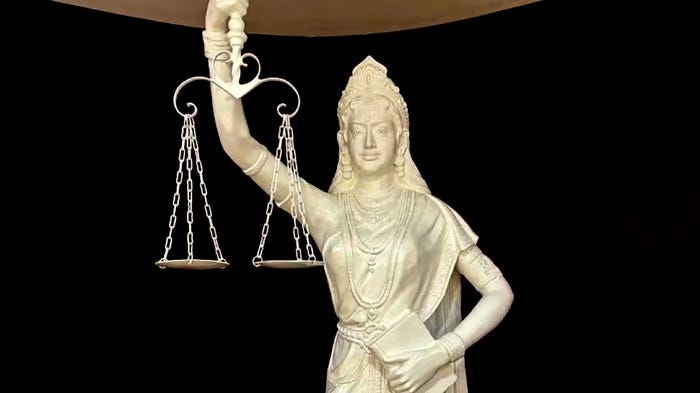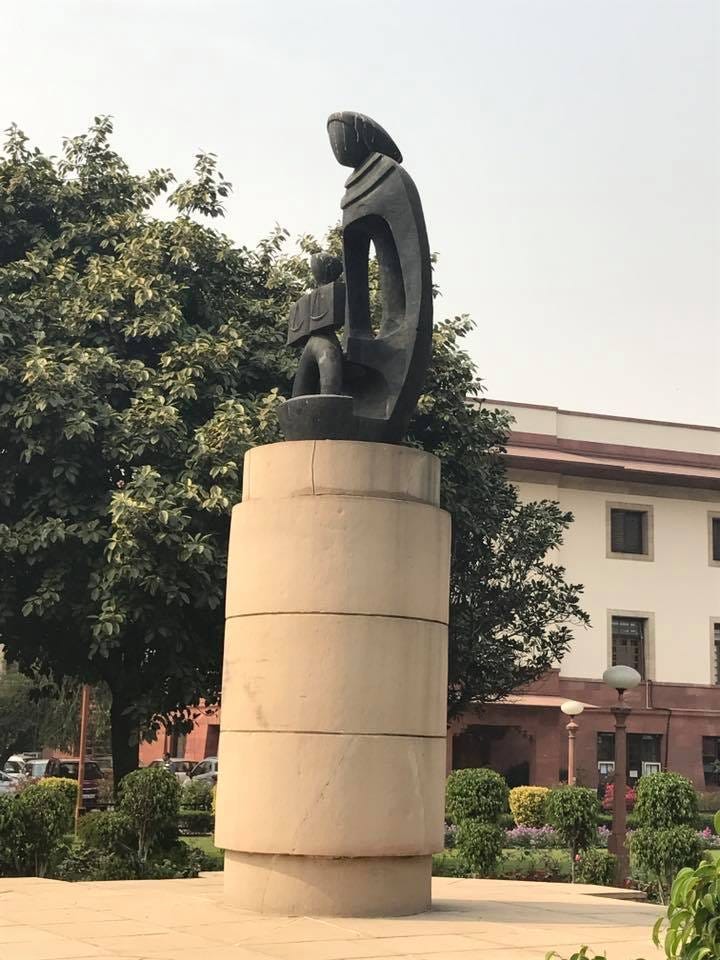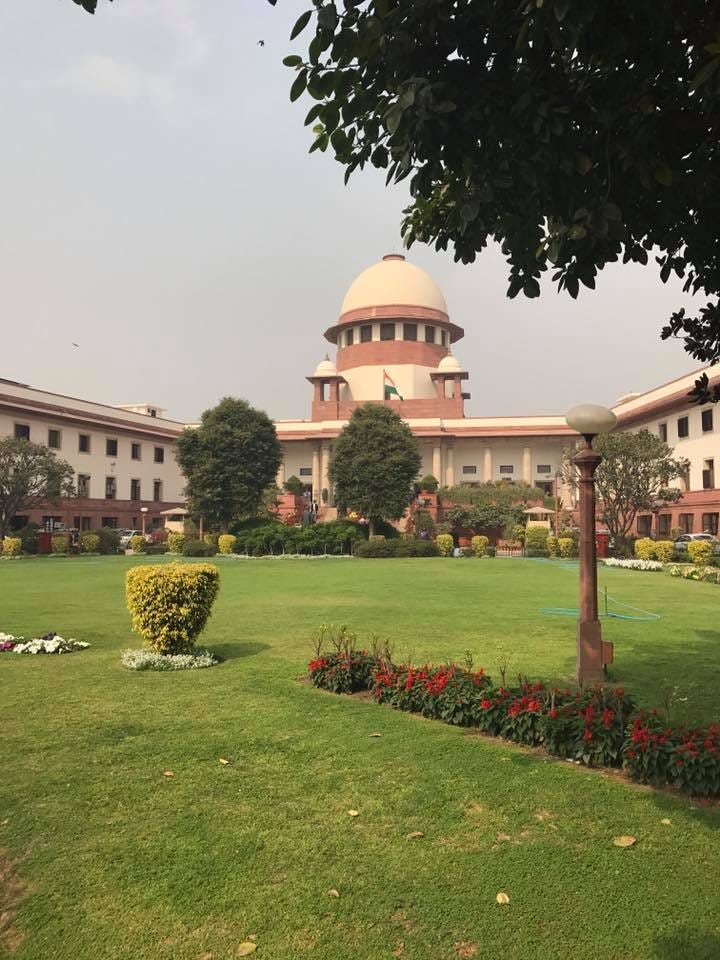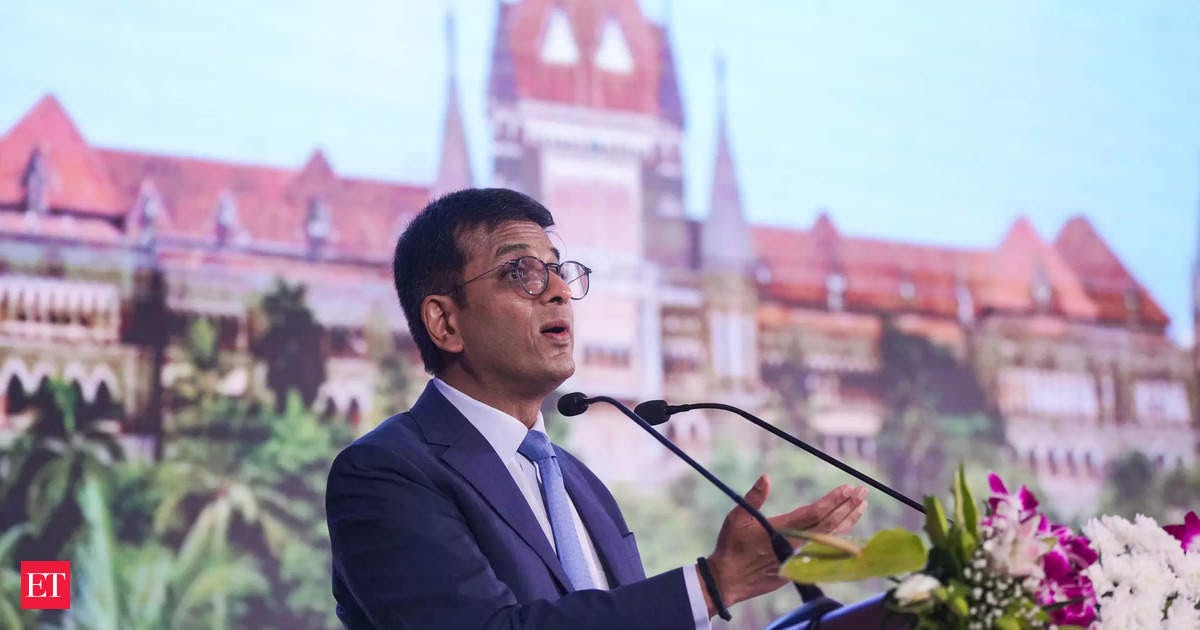CJI's Vision of a Justice System with Open Eyes, Sans the Sword
The sword represents not just the power to punish, but power to enforce justice, to ensure that the Constitution is not merely a symbolic document, but a living and enforceable supreme law of the land
Justice System with Open Eyes, Sans the Sword
On October 15, 2024, Chief Justice of India (CJI) D.Y. Chandrachud unveiled a new statue of Lady Justice in the Supreme Court of India, marking a significant departure from traditional representations. In this new rendition, Lady Justice is no longer blindfolded, and the sword she once held has been replaced with a copy of the Indian Constitution. According to CJI Chandrachud, this new image reflects a justice system that "is not blind" and “does not merely dispense punishment.” Instead, the law is seen as a conscious and deliberate force that carefully examines every matter under the guiding principles of the Indian Constitution.
Explaining the reasoning behind these changes, CJI Chandrachud stated, “The appearance of careful consideration and impartiality is important from both sides of the eyes of a worker,” suggesting that the judiciary needs to appear more open and engaged with the people it serves. By removing the blindfold and introducing the Constitution, the Chief Justice aimed to symbolise a modern justice system, one which scrutinises deeply and fairly, ensuring that justice is not just delivered, but understood by all as being based on the bedrock of the Constitution.
This new representation comes in the wake of several progressive initiatives under CJI Chandrachud’s leadership. These include the live-streaming of Constitutional Bench proceedings, the introduction of artificial intelligence to assist with court translations, and a broader effort to make the judiciary more transparent and accessible to the common citizen. However, these reforms have faced resistance from those who believe that altering such long-standing symbols risks undermining the traditional gravitas and impartiality of the judiciary.
The Sword: More Than Just a Symbol of Punishment
While the intention behind this transformation may be noble, the removal of the sword from Lady Justice’s hand, to us, is particularly troubling. Historically, the sword symbolised not just the power to punish, but the authority to enforce the law, to uphold the Constitution, and to protect the rights of citizens. Without the sword, how do we ensure that justice is more than just words on a page? The Constitution, while the supreme law of the land, cannot defend itself. It needs the backing of the state’s might—the power symbolised by the sword—not merely to punish, but to prevent violations of its core principles.
It is an unfortunate irony that while India’s legal system continues to expand with more laws and regulations, there is little retribution or punishment for those who violate the Constitution. Time and again, we see laws being struck down by the judiciary as unconstitutional, yet no action is taken against those who have enacted or enforced these unconstitutional provisions. Without the sword, the justice system risks becoming toothless, unable to protect the very document it reveres. This sword, therefore, is not a tool of fear, but one of necessity—a reminder that the state, through its judiciary, has the authority and responsibility to uphold the law, not just in theory, but in practice.
The scales of justice ensure that every case is measured fairly, but without the sword, these scales are powerless. The sword, in its true sense, represents the judiciary’s authority to enforce its decisions and ensure that justice is delivered. The statue’s new configuration, therefore, inadvertently suggests a weakening of this vital role at a time when the Constitution is under increasing threat from various quarters—be it political overreach, administrative indifference, or corporate dominance.
Blindfolded Justice: The Need for Impartiality
The blindfold traditionally worn by Lady Justice is a symbol of neutrality, ensuring that the law is applied equally to all, regardless of wealth, status, or power. By removing this blindfold, the symbolism shifts in a way that may raise concerns. The idea that "justice is blind" is deeply rooted in various legal traditions worldwide, and this concept has resonated particularly in modern democracies like India. The justice system must be seen as impartial, free from any external influence or prejudice.
Even in contexts far removed from the judiciary, such as university admissions in the United States, the notion of "needs-blind" admissions reflects a commitment to fairness—ensuring that decisions are based on merit, not financial status. Justice, too, must remain blind to external pressures, whether they come from powerful individuals, political parties, or corporations. Removing the blindfold from Lady Justice, even symbolically, could send a message that justice may now be more selective, influenced by who stands before her.
There is growing concern that certain sections of the legal fraternity, particularly a select group of senior advocates, may receive preferential treatment in court. These advocates, often well-connected and representing powerful clients, sometimes appear to enjoy differential access to judicial attention. The perception that some receive better hearings than others undermines the public’s faith in the impartiality of the judiciary. If Lady Justice is to remain a symbol of fairness, she must hear all citizens equally—without bias or favour—and her rulings must reflect not only empathy but enforceable judgments that stand up to scrutiny.
The Sword of Justice and Constitutional Authority
The judiciary’s primary role is not just to interpret the law but to ensure its enforcement. Article 142 of the Indian Constitution grants the Supreme Court vast powers to do "complete justice" in any case, while Article 143 provides advisory consultative jurisdiction. These provisions are crucial to maintaining the balance between the different branches of government and safeguarding the rights of citizens. However, these powers are underused in a judicial system that is often bogged down by routine Special Leave Petitions (SLPs) and other procedural matters. The Supreme Court could, and should, exercise its constitutional authority more assertively to address pressing national issues and prevent blatant violations of constitutional principles.
It is also concerning that despite the Constitution being hailed as the supreme law of the land, there is no real mechanism to punish those who violate it. Legislators, government officials, and even private actors often escape accountability when their actions are declared unconstitutional. The absence of punitive measures for constitutional violations weakens the judiciary’s role as the guardian of the Constitution. The sword, therefore, represents not just the power to punish, but the power to enforce justice, to ensure that the Constitution is not merely a symbolic document, but a living, enforceable set of principles that govern the nation.
Justice Beyond Symbolism: “Action is Eloquence”
At the end of the day, whether Lady Justice holds a sword or the Constitution, whether she is blindfolded or not, the real measure of justice lies in the outcomes it produces. The proof of the judiciary’s commitment to justice is not found in symbolic gestures or ceremonial reforms but in the delivery of justice to all citizens, regardless of their background. The judiciary must rise above tokenism and symbolism to focus on ensuring that justice is both done and seen to be done.
CJI Chandrachud’s reforms, particularly his emphasis on transparency and accessibility, reflect his genuine desire to modernise and improve the justice system. These are commendable initiatives, but they must be balanced with the need to preserve the judiciary’s authority to enforce the law decisively. As the guardian of the Constitution, the Supreme Court must ensure that it not only interprets the law but also protects it from those who seek to undermine it1.
Eventful Tenure
The two-year tenure of Chief Justice Chandrachud has indeed been an eventful one, marked by several landmark judgments, particularly by the Constitutional Bench he headed. One of the most notable was the scrapping of the contentious Electoral Bonds scheme, a decision that had far-reaching implications for the transparency of political funding. However, it is not within the scope of this article to delve deeply into each of these significant rulings.
As CJI Chandrachud prepares to demit office on 10th November, we wish him all the best and hope that his contributions to society continue, whether or not he chooses to accept a post-retirement assignment. His judicial legacy is bound to inspire and encourage generations to come— especially young lawyers— and we look forward to seeing how he will remain a meaningful force in public life.
End Piece
Justice is not blind, merely blindfolded—a symbol of impartiality and fairness. We would, any day, prefer it to one with eyes wide shut, where the truth is deliberately ignored. In the words of Shakespeare, “Action is eloquence.” It is not enough for judges to deliver ceremonial or formal speeches outside the court, which hold no binding legal authority. The judiciary must speak where it matters most—through its judgements—rendered without fear or favour, and with the assurance that these rulings will be enforced with the full weight of the law. Only then can Lady Justice fulfil her true purpose—not merely as a symbol of justice, but as a living embodiment of fairness, authority, and accountability, serving both the Constitution and the citizens.
Reflecting on His Own Journey: Chief Justice DY Chandrachud on Duty, Legacy, and History’s Judgment
Legacy of Chief Justice DY Chandrachud: Balancing Duty and Reflection









…….Words will not mean for the common people. Only and only action would bring out the so perceived vision, lady either blindfolded or open eyes…..
CJI's Justice System & his right thinking about common people is the best approach to help . He followed right way to make decisions . God bless him 🙏🙏🌺